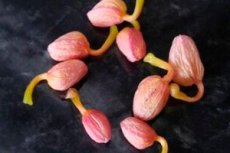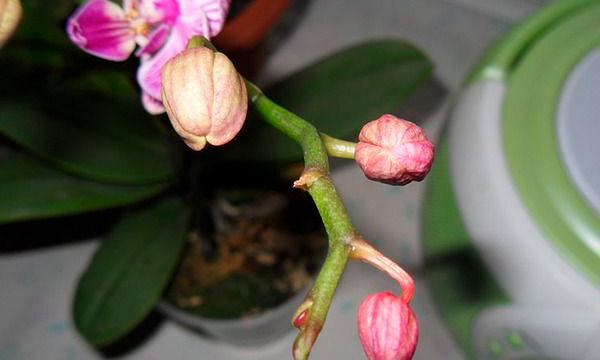Orchids are not blooming
Last reviewed: 29.06.2025

Orchids are stunning plants known for their exotic and beautiful flowers. However, if your orchid's buds are not opening, it can be concerning. Why do orchid buds dry out before blooming, and how can you help the plant bloom again? In this article, we’ll explore why orchid buds fail to bloom, what to do in such situations, and common mistakes to avoid.
Why don’t orchid buds open?
There are several reasons why orchid buds fail to bloom. Let’s explore what might be preventing their normal development:
1. Insufficient lighting
Orchids need adequate light for healthy growth and flowering. If the light is too weak, the buds may stop developing and dry out. This issue is especially common in species that require bright, diffused light.
Solution:
- Place the orchid near an east- or west-facing window.
- Use grow lights in winter to provide 12–14 hours of light per day.
2. Temperature fluctuations
Orchids are sensitive to sudden changes in temperature. Significant differences between day and night temperatures can cause buds to dry out instead of blooming. Orchids prefer stable temperatures between 18-25°c (64-77°f).
Solution:
- Maintain consistent temperatures of 18-25°c (64-77°f) during the day and 15-18°c (59-64°f) at night.
- Avoid placing orchids near cold drafts, heating vents, or air conditioners.
3. Low humidity
Humidity is another essential factor. If the air is too dry, orchid buds may not open. Orchids require humidity levels between 50% and 70%, especially during bud formation.
Solution:
- Use a humidifier or place the orchid on a humidity tray filled with water and pebbles.
- Regularly mist the leaves with warm water, avoiding direct contact with the buds.
4. Root overdrying or overwatering
The root system must stay properly hydrated. Overwatering can cause root rot, while underwatering can dry out the buds before they bloom.
Solution:
- Water the orchid only when the potting mix is completely dry but not dehydrated.
- Use the soaking method by submerging the pot in water for 10-15 minutes, allowing excess water to drain.
5. Incorrect fertilization
Both over-fertilizing and under-fertilizing can harm orchids. Excessive fertilizer can burn the roots, while a lack of nutrients can cause buds to fall off.
Solution:
- Use orchid-specific fertilizers with a balanced npk ratio of 10:20:20.
- Fertilize every 2–3 weeks during the active growing and blooming seasons.

Why orchid buds don’t bloom?
There are several reasons why orchid buds fail to bloom. Let’s examine what may be preventing them from developing properly:
1. Insufficient lighting
Orchids need adequate light for healthy growth and flowering. If the lighting is too weak, the buds may stop developing and dry out, especially in light-demanding species.
Solution:
- Place the orchid near an east- or west-facing window.
- Use grow lights during winter to provide 12–14 hours of light per day.
2. Temperature fluctuations
Orchids are sensitive to sudden changes in temperature. Significant differences between day and night temperatures can cause buds to dry out instead of blooming. Orchids thrive in stable temperatures between 18-25°c (64-77°f).
Solution:
- Maintain a consistent temperature of 18-25°c (64-77°f) during the day and 15-18°c (59-64°f) at night.
- Avoid placing orchids near cold drafts, heating vents, or air conditioners.
3. Low humidity
Humidity is another essential factor. If the air is too dry, orchid buds may not open. Orchids require 50-70% humidity, especially when forming buds.
Solution:
- Use a humidifier or place the orchid on a humidity tray filled with water and pebbles.
- Regularly mist the leaves with warm water, avoiding the buds.
4. Improper watering
The root system must stay properly hydrated. Overwatering can cause root rot, while underwatering can dry out the buds before they bloom.
Solution:
- Water the orchid only when the potting mix is completely dry but not dehydrated.
- Use the soaking method by submerging the pot in water for 10-15 minutes, allowing excess water to drain.
5. Incorrect fertilization
Both over-fertilizing and under-fertilizing can harm orchids. Excessive fertilizer can burn the roots, while a lack of nutrients can cause buds to fall off.
Solution:
- Use orchid-specific fertilizers with a balanced npk ratio of 10:20:20.
- Fertilize every 2–3 weeks during the active growing and blooming seasons.
Orchid buds are drying out: causes and fixes
If your orchid buds dry out and fall off, the reasons are often related to care mistakes or environmental factors. Let’s explore common causes and how to prevent this issue.
Main reasons for orchid bud drying
1. Temperature fluctuations
Cause: orchids are highly sensitive to temperature changes, especially when forming buds. Sudden drops at night or exposure to cold drafts can cause stress.
Solution:
- Maintain stable temperatures: 18-25°c (64-77°f) during the day and 15-18°c (59-64°f) at night.
- Avoid placing the orchid near windows with cold drafts or heating devices.
2. Insufficient lighting
Cause: without adequate light, orchids can’t photosynthesize properly, leading to bud loss.
Solution:
- Place your orchid on an east- or west-facing window.
- Use a grow light to extend daylight hours during the winter.
3. Improper watering
Cause: overwatering leads to root rot, while underwatering causes the potting mix to dry out, resulting in bud loss.
Solution:
- Water the orchid only when the substrate is completely dry.
- Use the soaking method for 10–15 minutes and ensure proper drainage.
4. Low humidity
Cause: orchids require a humidity level of 60–80%. Air that's too dry causes dehydration and bud loss.
Solution:
- Use a humidifier or a humidity tray filled with water and pebbles.
- Mist the leaves regularly, avoiding direct contact with buds.
5. Environmental changes
Cause: relocating the orchid, repotting, or changing its environment causes stress, leading to bud loss.
Solution:
- Avoid moving the orchid unless absolutely necessary.
- Allow the plant to adapt to new conditions for 1–2 weeks after purchase.
6. Nutrient deficiency
Cause: a lack of nutrients weakens the plant, while too much fertilizer causes root burn.
Solution:
- Feed the orchid every 2–3 weeks with a special orchid fertilizer diluted to half strength.
- Avoid fertilizing if the plant is stressed.
7. Pests and diseases
Cause: pests such as spider mites, aphids, or mealybugs, as well as fungal infections, can cause buds to dry out.
Solution:
- Inspect the plant regularly for signs of pests.
- Treat with insecticides or fungicides as needed
How to save an orchid with dry buds
- Prune dry buds:
- Carefully remove dry buds using sterilized scissors or pruners to prevent infections.
- Check the roots:
- Remove the orchid from its pot and inspect the roots.
- Healthy roots should be green or silvery and firm. Trim any dead roots and apply cinnamon or activated charcoal to cuts.
- Improve growing conditions:
- Ensure the orchid gets bright, indirect light, proper watering, and high humidity.
- Use growth stimulators:
- Use growth stimulators such as "epin" or "zircon" to support a stressed plant.
- Apply fertilizer only after root recovery.
How to prevent bud drying in the future
- Stable environment: avoid sudden changes in temperature, humidity, or location.
- Correct watering: water only when the substrate is dry, ensuring no water sits in the pot.
- Adequate light: use supplemental lighting in winter.
- Maintain humidity: use a humidifier or pebble tray.
- Regular monitoring: inspect the plant for signs of pests, diseases, or root problems.
Conclusion
If your orchid's buds are drying out, don’t worry — with proper care, it can recover and bloom again. By maintaining stable conditions, adjusting watering routines, and ensuring proper humidity, you can prevent future problems. Orchids thrive when given consistent attention and care. With patience and dedication, your orchid will reward you with stunning, long-lasting blooms.
